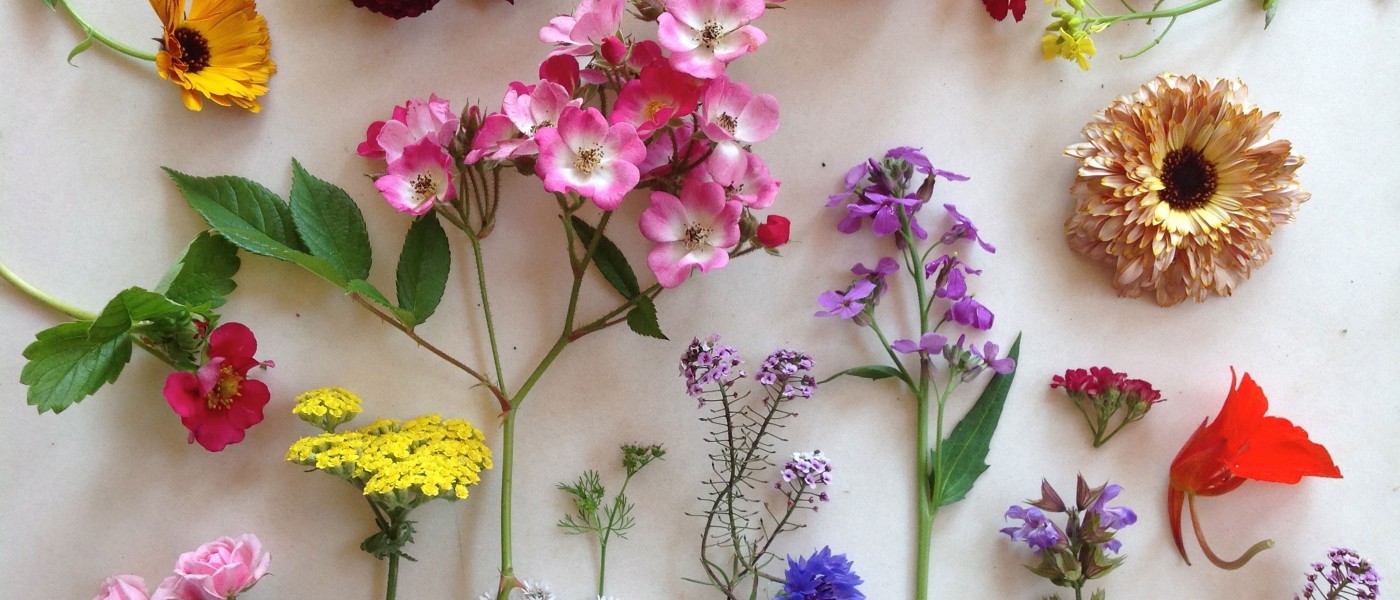Eat Local: How to Use Edible Flowers
Edible flowers, either harvested from your own garden or purchased from the farmer’s market, can add color, whimsy, and flavor to the seasonal table. Many are fairly easy to grow and are abundant now as spring moves into summer. They can be used fresh as garnish, made into syrups or cordials, candied into crystalized gems, frozen into ice cubes, or dried for tea. Among them you’ll find an array of rich colors, surprising flavors, and interesting textures beyond the well-known pansy, rose, and nasturtium.
When adding flowers to recipes, there are few rules to follow: Always positively identify any plant part before consuming. Do not assume a flower is edible just because it smells delicious and looks tasty! Also, harvest blooms in the cool hours of the morning or evening, and wash and dry them well before consumption.
In general, only eat the petals, discarding the sepals (outer leaves), as well as the carpels and stamens (the inner reproductive parts). These will often give a bitter or soapy flavor to your dish. A few exceptions are the very small florets of otherwise large umbelliferous racemes (rounded flower clusters that radiate from a central point) or corymbs (flat-topped flower clusters) such as cilantro, yarrow, and sweet alyssum (see photo).
Sorrel Caesar Salad with Fresh Strawberries
Yield: 4 entrée-size saladsSorrel (Rumex acetosa) is a perennial garden herb that has a bright and acidic flavor due to oxalic acid in the leaves. It is best harvested in the spring before it becomes tough and bitter.
If you cannot source crème fraiche, sour cream is an appropriate substitution. With the addition of grilled shrimp or chicken, this hearty salad performs as a main entrée.
Use a mix of edible flowers, including both sweet and spicy selections like chive blossoms, Brassica flowers, Dianthus, Calendula, and rose petals (see the list below for more options).
Ingredients- ½ cup crème fraiche
- ½ cup packed fresh sorrel leaves (about 14–16 medium leaves)
- 2 cloves garlic, coarsely chopped
- 14–16 flat anchovies in oil (about one 45 g jar)
- 4 tablespoons extra virgin olive oil
- 2 tablespoons fresh lemon juice
- generous pinch of sea salt
- black pepper to taste
- 1 head romaine lettuce
- 2–3 handfuls mixed greens (mustard, red-veined sorrel, amaranth, and tender pea tendrils all add varied texture and flavor)
- 1 pint fresh strawberries, hulled and chopped
- 1 handful fresh flower petals
Place the crème fraiche, sorrel, garlic, anchovies, oil, lemon juice, and salt and pepper in a medium bowl. Using an emersion blender, puree the ingredients until they become creamy and a consistent green color. (Alternatively, use a food processor and blend until the texture is smooth.) Taste and adjust the amount of salt and pepper according to preference.
Place the greens in a bowl and toss with the dressing, adding 2 to 3 tablespoons at a time to coat the greens. Add the chopped strawberries and flower petals as garnish and serve immediately. If you have any leftover dressing, it is excellent used as a dip for radishes, baby carrots, and fresh asparagus spears.
Common Edible Flowers by Flavor
Bitter
- marigold
- dandelion
- safflower
- saffron
- chrysanthemum
- hops
Spicy
- nasturtium
- the brassicas (arugula, radish, cardamine, and mustard flowers)
- dianthus
- bee balm
- cornflower
- perennial phlox
- alliums
Sweet
- wild violet
- borage
- burnet
- calendula
- chamomile
- primrose
- hosta
- clover
- tulip
- anise
- hyssop
- agastache
- milkweed
- yarrow
- dill
- chervil
- fennel
Intoxicating
- rose
- lilac
- lavender
- linden
- scented geraniums
- jasmine
- elderflower
- honeysuckle
- citrus
Nutty and Earthy
- lily
- banana
- okra
- squash
- yucca
- pea
- sweet woodruff
- sunflower
- Queen Anne's lace
- scarlet runner bean
Astringent
- redbud
- hibiscus
- begonia
- fuchsia
- mints (calamint, nepeta, peppermint, etc.)
- salvias (pineapple sage, clary sage, garden sage, etc.)
- lemon thyme
- lemon balm
- wood sorrel
- pansy
- Johnny jump-up
Neutral
- impatiens
- hollyhock
- peony
- mallow
- gladiolus
The Eat Local series features seasonal, locally available ingredients and recipes. It was the recipienct of a 2016 Silver Medal for Blog Writing from the Garden Writers Association.


